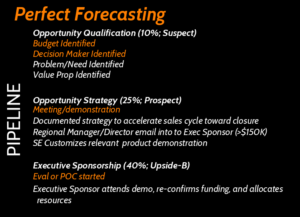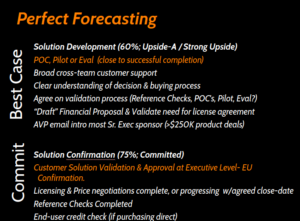
Forecasting & pipeline management are so critical to effective Inside Sales that one of the first things I teach my Inside Sales team is Perfect Forecasting*.
The key to teaching sales reps Perfect Forecasting is having a straightforward, well-defined process that is followed by everyone on the team.
Before making changes to the way my team forecasts, I meet 1:1 with every rep for a pipeline deep dive. Unless there is a solid standard forecasting methodology used across the team, we’ll make changes. (In nearly 20 years, I have yet to inherit a sales team that had a consistent forecasting and pipeline management processes.)
Reps have a variety of methods they’ll use to forecast. These are so common, I have nicknamed them.
- No Guts: I keep everything at 10% until I am told a PO is being cut
- Sandbagger: I don’t put every Opportunity in the CRM. Or I’ll put a close date 5 years out. Or I’ll make the $ amount really low. That way management won’t ask me about the deal and I’ll have a few to cover in case a deals falls out.
- Happy Ears: I’m sure my customer will purchase this quarter – even though I don’t know their buying triggers and I was certain it would close last quarter.
- 50/50: There’s a 50/50 chance of winning the deal. (This ALWAYS means the rep has NO clue if the deal will close).
- Bluebird: I create the opportunity in Salesforce only after I have the PO in hand.
- Guessing: I arbitrarily assign probabilities and close dates. I may base these on: the length of time an opportunity has been open, when quotas close, vacation schedules, astrological signs, etc.
As a sales rep, I used 50/50 and Guessing before I learned a better method.
If you have not done a pipeline deep dive with your reps, I encourage you to do so. It could be quite revealing and even humorous.
Creating Perfect Forecasting Stages and Checklists
After I’ve completed the pipeline deep dives, I’ll pull in my 1 or 2 Top Reps (TRs) to work on this project with me.
First, I’ll review my 3 Big Rocks which usually are:
- Crush our quota
- Forecast accurately
- Uplevel the team’s sales skills
I’ll explain why forecasting & pipeline management are important to the reps, me, our executives and the board.
Next I’ll review my findings from the pipeline deep dives. Usually the TRs will use a decent forecasting/ pipeline management process. At the same time, they’ll recognize that every rep on the team does it “his own way”.
We’ll then use a whiteboard to work together on these steps:
- List sales stages and probabilities %s for use in the CRM. Use descriptive, self explanatory names*.
- Create a short checklist of requirements for each stage.
After we complete this, I’ll draft 2 slides that list Perfect Forecasting stages, probabilities and requirements to review with the TRs. Even if I think I know exactly what I want to implement, I’ll solicit the TR’s input. They understand the culture, sales processes and day-to-day rep activities better than I do. Going forward, I will frequently rely on the TRs for their “real world” insight. I want them to become very comfortable partnering with me to create solutions.
Rolling It Out to the Team
Then I’ll tell the TRs that I need their help to launch Perfect Forecasting and get the rest of the sales team to buy in. This always pays major dividends. The TRs become my best advocates for Perfect Forecasting. Since they helped create they process, they take ownership to make it work.
I’ll roll out Perfect Forecasting in my next team meeting. I’ll explain why the TR’s and I came up with the plan. We’ll discuss my expectations for using Perfect Forecasting going forward. Because this is a major change, there are always questions. I’ll have the TRs field some of the questions to help establish them as the go-to experts.
I’ll assign the team 3 action items:
- Every rep must print the two Perfect Forecast slides to put up in his cube.
- Starting the next day, I want the reps to reforecast their current pipeline according to Perfect Forecasting.
- All new Opps will be managed using this method.
Implementing Perfect Forecasting
Two days later, I’ll begin regular weekly pipeline deep dives. These are done on the sales floor. We’ll sit together at their desk, reviewing & discussing opportunities. We use the Perfect Forecasting slides to dictate how each opportunity should be worked. See this post for how to do an effective PipelineDeep Dive.
After a few weeks of pipeline deep dives, the team will have Perfect Forecasting locked down.
Once we have the data from a full quarter, I’ll teach the reps how to forecast their actual expected bookings from their pipelines. (For more on this, see my post on Perfect Forecasting for Managers). For now, it’s enough for the reps to become comfortable implementing the process and having opportunities in the correct stages.
Here’s a real-life Perfect Forecasting model I used in a previous company.
- We sold software & computer hardware.
- We had quarterly quotas (calendar quarter).
- We used Salesforce as our CRM.
- Reps qualified leads, created opportunities and ran them to close.
- The average sales cycle was 3-6 months.
Feel free to adjust the parameters to match your own business.
Close Dates
Until an Opp reaches 40%, the close date should be the end of calendar quarter (Mar 30, June 30, Sept 30, or Dec 31). I tell the team to default to 4 QTRs out unless they had a good reason to make it sooner. Once an Opp reached 60%, the close date was moved to the the end of the current or next quarter. Using end of quarter close dates until an Opp reached 75% solves several issues: 1) Reps now had a way to know which deals to work in a given quarter 2) Reps only had to update close dates a few times per opportunity vs. every month.
———-
Example 1.
10% Opportunity Qualification
- Budget – confirmed or available
- Authority – speaking with decision maker (DM) or decision influencer (often an IT Manager)
- Need – identified
- Time – purchase within 12 months
- Next step: Presentation meeting scheduled.
25% Presentation
- Meeting with a demo performed
- Whiteboard discussion of customer’s technical environment
- Next steps defined for moving to Eval/POC
40% EVAL
- Eval/POC started
- DM attends demo, reconfirms funding and allocates resources for eval
- Potential roadblocks/objections identified & being addressed
- Next steps defined for moving to BEST CASE
60% BEST CASE
- EVAL/POC completed (or close to completion)
- Clear understanding of decision making & purchasing process
- Proposal/quote presented to DM
- Next steps defined for moving to COMMIT
75% COMMIT
- Verbal commitment from customer
- Customer confirms our product meets their needs
- Price and terms negotiations complete (or progressing with an agreed close date)
- Purchasing prerequisites complete (Reference checks, Credit Checks, Reseller quotes etc.)
- Next steps defined for moving to CLOSED WON
100% CLOSED WON
- Contracts signed, POs in hand, Product Shipped.
Example 2. Below are screen shots of 2 Perfect Forecasting Slides I used when managing a different sales team. In this case, I followed the stage names and requirements as directed by my VP*. I highlighted some key focus areas for my Inside Sales Reps in orange.


Wrapping it up
Perfect Forecasting removes the guesswork from sales rep forecasting & pipeline management. It establishes clear criteria for opportunities at every stage of the sales process. It provides Inside Sales Managers with a more accurate view of the pipeline, revenue opportunity and the deals that can help the team crush quota. I’ve used it with teams from 6 to 100 reps running opportunities ranging from as low as $150 to as high as $1M.
If your forecasting is still too much of a guessing game, I encourage you to give Perfect Forecasting a try.
*In some cases, I cannot change the CRM field names- especially in larger companies. In those cases, we’ll use the existing stage names but will define what they mean for my team via the checklists.
*The term Perfect Forecasting was coined by a Scott Henderson, one of the best-of-the-best Sales VP’s. He taught this method to our entire team. I co-opted it and have used it ever since.
Want more like this? Subscribe to receive my newsletter
[mc4wp_form id=”1491″]